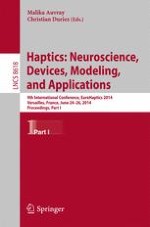2014 | OriginalPaper | Buchkapitel
Virtual Roughness Perception Using Coil Array Magnetic Levitation Haptic Interface: Effects of Torque Feedback
verfasst von : Sahba Aghajani Pedram, Roberta Klatzky, Oran Isaac-Lowry, Peter Berkelman
Erschienen in: Haptics: Neuroscience, Devices, Modeling, and Applications
Verlag: Springer Berlin Heidelberg
Aktivieren Sie unsere intelligente Suche, um passende Fachinhalte oder Patente zu finden.
Wählen Sie Textabschnitte aus um mit Künstlicher Intelligenz passenden Patente zu finden. powered by
Markieren Sie Textabschnitte, um KI-gestützt weitere passende Inhalte zu finden. powered by
